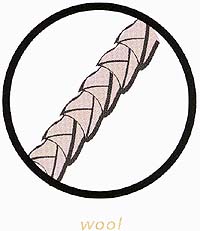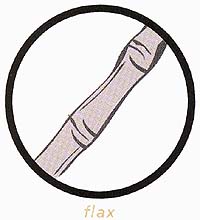|
Fibers exist in nature in many guises. Animal, vegetable, and mineral substances all provide the raw material for cloth. The wool of the sheep, the hair and fur of other creatures, and the fine filament from which the silk worm spins his cocoon are animal fibers composed of protein. Dozens of plants produce usable fiber in cellulose form. For example, linen is made from the fibrous stalk of the flax plant. The familiar cotton fiber grows as a puff protecting the seeds of the cotton plant, and even grasses and leaves provide a variety of textile fibers. Metals are pounded into foils and cut into strips for luxurious metallic fabrics. The unmistakable characteristics of the natural fibers are born in their structure. The familiar warmth of wool, the downy softness of cotton, the rich, dry texture of silk, and the crisp sheen of linen originate in the plant or animal that made them, and from the fact that natural things can never be quite uniform. The irregularities in their formation give them their distinction and explain many of their peculiar properties, such as the ability of wool to lock into felted constructions, the generally high absorbency of natural fibers, and the wide variation in quality among fibers of the same type. |

WOOL is among nature’s masterpieces. The
fuzzy coat of the sheep possesses several remark able and unique
properties that make it especially adaptable to textile use.
The wool fiber, which varies in length from 1 1/2" to 15" (3.8
cm to 38 cm), has a natural crimp that facilitates the spinning
of yarns and increases elasticity. The fiber itself is covered
with minute scale. When wool is subjected to heat and pressure,
these scales interlock, holding the fibers together and creating
wool’s unique felting capacity. The protein molecule that wool
is composed is spiral, or spring-shaped, contributing great
resiliency, “loft," and shape-keeping ability. The fabric
is highly absorbent and consequently very receptive to dyes
but, in contrast, the surface tends to shed water. The hair
and fur of other animals such as alpaca, vicuna, and cashmere
goat also contribute fibers that are classified as wool, and
possess these properties in varying degrees. |
Searching for sewing or craft supplies like sewing machines, sergers, yarn, and knitting supplies? Browse our online catalog pages here:
Or see what products on our site the popular search engines have chosen to list...
- Google listing
of all "Fabric" items on our site
- Yahoo! listing
of all "Fabric" items on our site
- Alta Vista listing of all "Fabric" items on our site
Recommended Reading
Recommended Products
Want to learn more about sewing, knitting and related arts and crafts? Browse our reading list.
If you need specific fabric supplies, have a look at these pages:
SILK has a romantic history shrouded in regal legend, and the silk worm’s life cycle is itself an exciting drama. A moth lays eggs that, after an incubation period, hatch into tiny, hungry silk worms. In about a month, each worm eats thousands of times its weight in mulberry leaves, growing rapidly and shedding its skin several times. Then it spins its cocoon. If allowed to continue the cycle, the worm transforms itself into a moth, which emerges from the cocoon to mate and lay more eggs. If the cocoon is to be used for silk, however, the worm is baked and dried in its blanket, and the fine protein fiber is unreeled in a continuous filament, which may be from 1 500 to 4000 feet (450 m to 1200 m) long. A stiff natural gum called sericin is boiled away, and silk filaments are combined to form very fine threads. Silk is extremely strong, absorbent, warm, resilient, and highly elastic.
COTTON is a vastly popular, versatile, and relatively inexpensive fiber that produces durable, comfortable fabrics. Magnified cotton has a ribbon-like appearance and is of fairly uniform thick ness. The many types of cotton fibers range in length from 1/2" to 2 1/2" (13 mm to 6.5 cm). It is naturally soft and easily spun into a variety of textures. The cellulose of which cotton is com posed is an inert substance, and as a result untreated cotton may have little resiliency and wrinkle easily. However, its normally high strength increases when wet, making it exceptionally easy to launder, and its natural absorbency makes it receptive to a variety of treatments, such as mercerization, color application, and wrinkle-resistant and easy-care finishes, which add to its desirability.
FLAX is the plant from whose stems linen is made. By a process developed at the dawn of civilization, the outer woody portion of the stalk is rotted away, leaving long, soft, strong fibers composed of cellulose. The magnified fiber has a jointed structure similar to that of bamboo, and the thickness may vary widely. Length ranges from 5” to 20” (12.5cm to 51 cm). Because of their similar composition, linen resembles cotton in many ways, including its ability to withstand high temperatures and it’s easy to launder with low resistance to wrinkling. In addition, it is extremely durable and, if stored properly, will withstand years of use. However, the flax fiber tends to be stiffer than cotton, and linen fabrics are subject to abrasion and wear along edges and creases. Other plant fibers that are similar to linen are hemp, jute, ramie and even bamboo. These are known as bast fibers as they are found in the stem of the plant.



